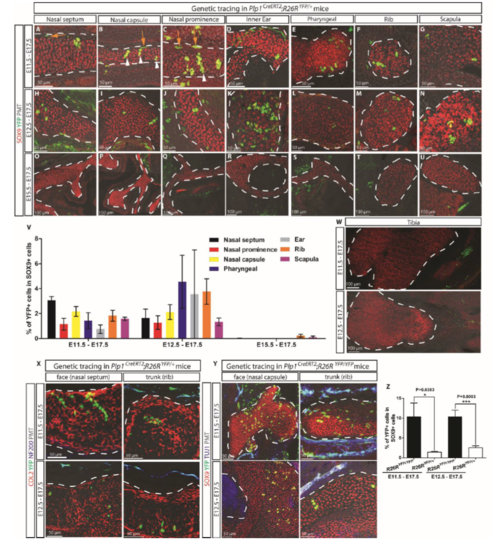Fig. s4
- ID
- ZDB-FIG-200618-9
- Publication
- Xie et al., 2019 - Schwann cell precursors contribute to skeletal formation during embryonic development in mice and zebrafish
- Other Figures
- All Figure Page
- Back to All Figure Page
|
(A-W) Genetic tracing of Plp1CreERT2;R26RYFP/+ embryos revealed contribution of SCPs to various craniofacial and trunk skeletons when injected with tamoxifen at E11.5 (A-G) or E12.5 (H-N), but not at E15.5 (O-U) and analyzed at E17.5. White arrowheads in (B-C) indicate YFP+SOX9+ cells that formed transversal columns. Orange arrows in (A-C) indicate YFP+ perichondrial cells. No contribution to the tibia growth plate was observed (W). Genetically labeled cells and chondrocytes were visualized with anti-GFP (green) and anti-SOX9 (red) antibodies, respectively. (V) Quantification of YFP+ cells among the SOX9+ cell population in different craniofacial and trunk structures of embryos genetically traced from E11.5, E12.5 or E15.5 to E17.5. Data represent mean ± SEM where at least 3 embryos from independent litters were analyzed. The white dashed lines outline the cartilage structures. (X) Collagen type II (COL2, red) immunostaining was employed to visualize cartilage elements, progeny of SCPs were visualized with anti-GFP (green) antibody and nerves with NF200 (blue) in Plp1CreERT2;R26RYFP/+ embryos injected tamoxifen either at E11.5 or E12.5 and analyzed at E17.5. (Y-Z) Comparison of R26RYFP homozygous (Plp1CreERT2;R26RYFP/YFP) to R26RYFP heterozygous embryos (Plp1CreERT2;R26RYFP/+, utilized throughout the study) revealed a significantly higher number of SCP progenies in cartilage elements of the homozygous embryos. Representative images (Y) and statistical analysis (Z) are shown for embryos labeled at either E11.5 or E12.5 and analyzed at E17.5. Genetically traced cells were visualized with an anti-GFP (green) antibody, cartilage cells with an anti-SOX9 (red) antibody and nerves with anti-TUJ1 antibody (blue). Data represent mean ± SEM, p values calculated with student’s t-test where at least 3 embryos from independent litters were analyzed. |

